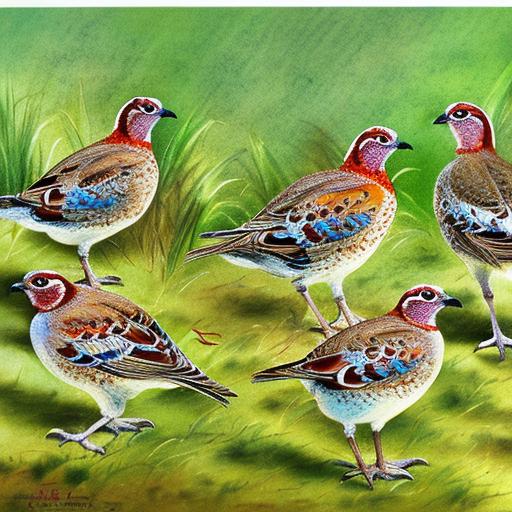Quail farming has been gaining popularity in the Philippines due to the increasing demand for quail eggs and meat. Quails are small, ground-dwelling birds that are known for their fast growth and high egg production. There are several quail breeds that are commonly raised in the Philippines, each with its own unique characteristics and advantages. Quail farming is a lucrative business in the Philippines, providing a sustainable source of income for many farmers and entrepreneurs. In this article, we will explore the popular quail breeds in the Philippines, their characteristics, breeding and rearing techniques, economic importance, as well as the challenges and opportunities for quail breeders in the country.
Key Takeaways
- Quail breeding is a popular and economically important activity in the Philippines, with several different breeds being raised for their meat and eggs.
- Some popular quail breeds in the Philippines include the Japanese quail, the Bobwhite quail, and the Coturnix quail, each with their own unique characteristics and advantages.
- Different quail breeds have varying characteristics such as size, color, and egg production, making them suitable for different purposes and markets.
- Breeding and rearing quail in the Philippines requires proper housing, feeding, and management practices to ensure optimal growth and productivity.
- Quail breeding offers opportunities for income generation and food security in the Philippines, but breeders also face challenges such as disease management and market competition.
Popular Quail Breeds in the Philippines
In the Philippines, there are several popular quail breeds that are commonly raised for their eggs and meat. The Japanese quail, also known as Coturnix quail, is one of the most popular breeds due to its high egg production and fast growth rate. Another popular breed is the Bobwhite quail, which is known for its flavorful meat and adaptability to different environments. The Pharaoh quail is also commonly raised in the Philippines for its large-sized eggs and good meat quality. These three breeds are the most commonly raised quail breeds in the Philippines, each with its own unique characteristics and advantages.
The Japanese quail is known for its high egg production, with each bird laying up to 300 eggs per year. They are also fast-growing birds, reaching maturity in just 6-8 weeks. The Bobwhite quail, on the other hand, is prized for its flavorful meat and adaptability to different climates. They are also known for their strong flying ability, making them popular for hunting purposes as well. The Pharaoh quail is larger in size compared to the Japanese quail and is known for its large-sized eggs and good meat quality. These popular quail breeds in the Philippines offer different advantages to farmers and entrepreneurs, making them a valuable asset in the poultry industry.
Characteristics of Different Quail Breeds
Each quail breed has its own unique characteristics that make them suitable for different purposes in the poultry industry. The Japanese quail, also known as Coturnix quail, is prized for its high egg production, fast growth rate, and adaptability to different environments. They are also known for their docile nature, making them easy to handle and manage. The Bobwhite quail, on the other hand, is known for its flavorful meat, strong flying ability, and adaptability to different climates. They are also popular for hunting purposes due to their strong flying ability. The Pharaoh quail is larger in size compared to the Japanese quail and is known for its large-sized eggs and good meat quality. They are also relatively easy to raise and manage, making them a popular choice for many farmers in the Philippines.
Each quail breed has its own unique advantages and characteristics that make them suitable for different purposes in the poultry industry. The Japanese quail is popular for its high egg production and fast growth rate, making it a valuable asset for egg production. The Bobwhite quail is prized for its flavorful meat and adaptability to different climates, making it a popular choice for meat production and hunting purposes. The Pharaoh quail, with its large-sized eggs and good meat quality, offers a valuable option for farmers looking to raise quails for both eggs and meat production. Understanding the characteristics of different quail breeds is essential for farmers and entrepreneurs looking to start a quail farming business in the Philippines.
Breeding and Rearing Quail in the Philippines
Breeding and rearing quails in the Philippines require careful planning and management to ensure successful production of eggs and meat. Quails are relatively easy to breed and rear, making them a popular choice for many farmers and entrepreneurs in the country. When breeding quails, it is important to provide them with a suitable environment that mimics their natural habitat. This includes providing proper housing, feeding, and management practices to ensure their health and productivity. Quails can be bred using natural mating or artificial insemination, depending on the farmer’s preference and resources.
Rearing quails involves providing them with proper nutrition, housing, and management practices to ensure their growth and productivity. Quails require a balanced diet that includes protein-rich feeds to support their rapid growth and high egg production. Proper housing is also essential to protect them from predators and provide them with a comfortable environment for laying eggs and raising their young. Management practices such as regular health checks, vaccination, and disease prevention are also important to ensure the overall well-being of the quails. By implementing proper breeding and rearing practices, farmers can maximize the productivity of their quail farm and ensure a sustainable source of income.
Economic Importance of Quail Breeds in the Philippines
Quail farming plays a significant role in the economy of the Philippines, providing a sustainable source of income for many farmers and entrepreneurs. The high egg production and fast growth rate of quails make them a lucrative business venture for many individuals looking to enter the poultry industry. Quail eggs are in high demand due to their nutritional value and health benefits, making them a popular choice among consumers. Quail meat is also prized for its flavor and lean protein content, further contributing to the economic importance of quail farming in the Philippines.
The economic importance of quail farming extends beyond just egg and meat production. Quail farming also provides employment opportunities for many individuals involved in the production, processing, and marketing of quail products. The demand for quail eggs and meat has created a thriving market for quail products, contributing to the overall economic growth of the poultry industry in the Philippines. Additionally, quail farming promotes sustainable agriculture practices by providing an alternative source of protein that requires less space and resources compared to traditional poultry farming. The economic importance of quail breeds in the Philippines highlights their significant contribution to food security, employment generation, and sustainable agriculture practices.
Challenges and Opportunities for Quail Breeders in the Philippines

While quail farming offers numerous opportunities for farmers and entrepreneurs in the Philippines, it also comes with its own set of challenges. One of the main challenges faced by quail breeders is disease management and prevention. Quails are susceptible to various diseases that can significantly impact their productivity and overall well-being. Implementing proper biosecurity measures, vaccination programs, and regular health checks are essential to prevent disease outbreaks and ensure the health of the quails.
Another challenge faced by quail breeders is market competition and price fluctuations. With the increasing popularity of quail products, there is a growing competition among producers, leading to price fluctuations that can affect the profitability of quail farming businesses. Additionally, ensuring consistent quality and supply of quail products is essential to maintain a competitive edge in the market.
Despite these challenges, there are also numerous opportunities for quail breeders in the Philippines. The growing demand for quail eggs and meat presents an opportunity for farmers to expand their production and tap into new markets. Diversifying product offerings such as value-added products like pickled quail eggs or quail meat products can also create new opportunities for farmers to increase their revenue streams. Furthermore, advancements in technology and farming practices offer opportunities for farmers to improve their production efficiency and reduce operational costs.
The Future of Quail Breeds in the Philippines
Quail farming has become an integral part of the poultry industry in the Philippines, offering numerous economic opportunities for farmers and entrepreneurs. The popularity of quail eggs and meat continues to grow due to their nutritional value, health benefits, and versatile culinary uses. As consumer demand for quail products continues to rise, there is a promising future for quail breeds in the Philippines.
To ensure the sustainable growth of the quail farming industry, it is essential for farmers to implement proper breeding and rearing practices, disease management strategies, and market-oriented approaches. By addressing these key areas, farmers can maximize their productivity, profitability, and contribution to the overall economy of the Philippines.
In conclusion, quail breeds play a vital role in providing a sustainable source of income, employment opportunities, and nutritious food products in the Philippines. With proper management and strategic planning, the future of quail breeds in the country looks promising, contributing to the overall development of the poultry industry and agricultural sector.
If you’re interested in learning more about poultry breeds and their egg-laying habits, you might also want to check out this informative article on how many eggs geese lay. It provides valuable insights into the egg production of geese, which can be helpful for poultry enthusiasts looking to diversify their flock.
FAQs
What are the different quail breeds in the Philippines?
In the Philippines, some of the common quail breeds include the Japanese quail (Coturnix japonica), the Bobwhite quail (Colinus virginianus), and the King quail (Excalfactoria chinensis).
What are the characteristics of Japanese quail?
Japanese quail, also known as Coturnix quail, are the most common breed raised for commercial production in the Philippines. They are known for their fast growth, high egg production, and adaptability to various environmental conditions.
What are the characteristics of Bobwhite quail?
Bobwhite quail, also known as Virginia quail, are popular for their distinctive whistling call. They are smaller in size compared to Japanese quail and are often raised for their meat and as game birds.
What are the characteristics of King quail?
King quail, also known as Chinese painted quail, are the smallest of the quail breeds commonly raised in the Philippines. They are known for their colorful plumage and are often kept as ornamental birds.
What are the uses of quail breeds in the Philippines?
Quail breeds in the Philippines are primarily raised for their meat and eggs. They are also popular as game birds and for their ornamental value in aviculture.
Meet Walter, the feathered-friend fanatic of Florida! Nestled in the sunshine state, Walter struts through life with his feathered companions, clucking his way to happiness. With a coop that’s fancier than a five-star hotel, he’s the Don Juan of the chicken world. When he’s not teaching his hens to do the cha-cha, you’ll find him in a heated debate with his prized rooster, Sir Clucks-a-Lot. Walter’s poultry passion is no yolk; he’s the sunny-side-up guy you never knew you needed in your flock of friends!







